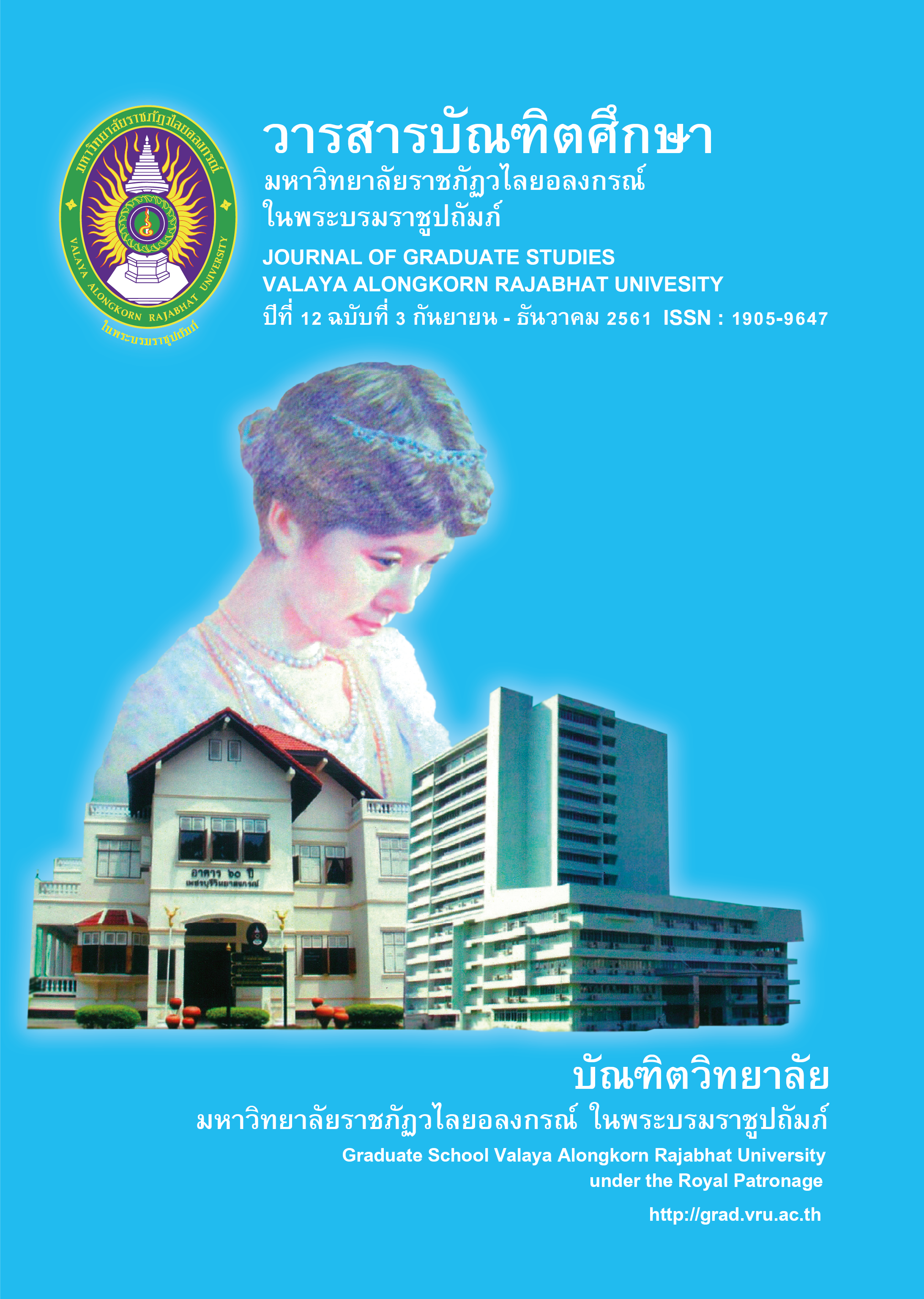MODEL FOR PREPARING RAJABHAT UNIVERSITY STUDENTS DEVELOPMENT IN THE CENTRAL REGION FOR THE ASEAN COMMUNITY
Main Article Content
Abstract
This research aimed to 1) develop models of student development for Rajabhat Universities in the central region to prepare for ASEAN Community, and 2) to study effectiveness of the models used for developing students at Rajabhat Universities in the central region. There were 2 groups of the samples. The 50 experts who formulated the policy, the administrators of student and incharge of student development activities. The samples ware 250 students of 5 Rajabhat Univerities in the central region (each for 50 students). The research instruments are interview, questionnaires, plan for implementing of develop the students and evaluation form. The procedure of research. Phase 1 to review iterative. Phase 2 to study the student development affairs of Rajabhat University in the central region-about preparing for ASEAN Community. Phase 3 Draft the “Module of Student Development for Rajabhat University in the Central Region to prepare for ASEAN Community”. Phase 4 Develop the “Models of student Development for Rajabhat University in the Central Region to prepare for ASEAN Community” and analyze the effectiones of the models.
The results showed that:
1. The results showed that there were four procedures in the student development model for Rajabhat Universities in the central Regions the principles and processes involved in the development of students in Central Rajabhat University to support the entry into the ASEAN Community. 1) Principles of Principles of Student Development Policy. Part 1 promotes morality and ethics. Part 2 Caring for the environment or protecting the environment. Part 3 Sports or Health Promotion Part 4 desirable graduate features. (Determined by the university) Part 5 Art and Culture Promotion and the principles of practice, skills development and features to students are ready in three aspects: the availability of knowledge. Process skills and attitudes. 2) Steps to follow the student development model for entry into the ASEAN community 4 steps: is seeking knowledge, raise awareness, establishing values, self-combining and changing towards ASEAN Citizenship. 3) The process will show how to perform each step.
Step 1: Seeking Knowledge there are five stages of implementation. Phase 1: of Common Thinking. Phase 2: Collaboration. Phase 3: Common Problem Solving. Phase 4: Drive together. and Phase 5: Learning together.
Step 2: Raise awareness there are 3 processes. Side 1: stimulates thinking by using questions. Side 2: realizes the importance of common vision. And Side 3: Can be done manually. With reasonable in a changing situation.
Step 3: Establishing Values There are 3 processes. Side 1: Personal Values. Side 2: values group. Side 3: Social or community values.
Step 4: Self-Combining and Changing towards ASEAN Citizenship There is a process for reflection. This is the final step that results from the integration of all processes. Integrate knowledge, skills, and attitudes towards change in the ASEAN community.
2. The effectiveness of module of student development for Rajabhat University in the central region to prepare for ASEAN Community found that overall were at high level. For effectiveness of each aspect found that process skills at the highest level, knowledge, attitudes and self-combining and changing towards ASEAN citizenship at high level respectively. The results from Confirmatory Factor Analysis influencing skills and affective domains of the students of Rajabhat Universities in the central region for the ASEAN Community showed that there were seven observable factors: Knowledge Understanding and Applicability (KNOWL), Self-development Skills (DELOPEM), Citizenship Skills (POPU), Pride of Thai Identity and ASEAN Uniqueness (PROUD), Acceptance of Cultural Diversity (CULTURE), Environmental Awareness (SURROUND), and Living in Peace (PEACE). The validation of the goodness of fitted of the model was at the ‘Excellent’ level and yielded a Chi-square of 13.58, at the Degrees of Freedom (df) of 8, the probability at 0.093. The Goodness of Fit Index and the Adjust Goodness of Fit Index were at 0.992 and 0.973 respectively. The Root Mean Square Error of Approximation was at 0.037 and the Standardized Root Mean Square Residual was at 0.013. From the above data shown, it revealed that < 2 was at 1.697 and p was higher than .05. The resulted showed that the variables in the proposed model were consistent with the empirical data. In terms of the skills and affective domains of the students of Rajabhat Universities in the central region for the ASEAN Community, the seven observable factors: Knowledge Understanding and Applicability (KNOWL), Self-development Skills (DELOPEM), Citizenship Skills (POPU), Pride of Thai Identity and ASEAN Uniqueness (PROUD), Acceptance of Cultural Diversity (CULTURE), Environmental Awareness (SURROUND), and Living in Peace (PEACE) had the factor loading at 0.843, 0.832, 0.929, 0.758, 0.804, 0.738, and 0.316 respectively. Moreover, the Citizenship Skills (POPU) had the highest factor loading at 0.929 and the covariation with the skills and affective domains of the students of Rajabhat Universities in the central region for the ASEAN Community at 86.20 (R2 = 0.862) significantly at .05 level.
Article Details
บทความทุกเรื่องได้รับการตรวจความถูกต้องทางวิชาการโดยผู้ทรงคุณวุฒิ ทรรศนะและข้อคิดเห็นในบทความวารสารบัณฑิตศึกษา มหาวิทยาลัยราชภัฏวไลยอลงกรณ์ ในพระบรมราชูปถัมภ์ มิใช่เป็นทรรศนะและความคิดของผู้จัดทำจึงมิใช่ความรับผิดชอบของบัณฑิตวิทยาลัย มหาวิทยาลัยราชภัฏวไลยอลงกรณ์ ในพระบรมราชูปถัมภ์ กองบรรณาธิการไม่สงวนสิทธิ์การคัดลอก แต่ให้อ้างอิงแหล่งที่มา
References
กรมประชาสัมพันธ์ ศูนย์ข้อมูลข่าวอาเซียน. (2554). ความร่วมมือด้านการศึกษาอาเซียน. สืบค้นจากwww.aseanthai.net/ewt_news.php?nid=3947 (15 กันยายน 2557).
จิรวัฒน์ วีรังกร. (2554). "การวิเคราะห์ผลสัมฤทธิ์การดำเนินงานโครงการบัณฑิตยุคใหม่มหาวิทยาลัยเกษตรศาสตร์". การประชุมวิชาการ ครั้งที่ 44 มหาวิทยาลัยเกษตรศาสตร์, 30 มกราคม - 2 กุมภาพันธ์ 2006, กรุงเทพมหานคร ราชอาณาจักรไทย.
เปรื่อง กิจรัตน์ภร. (2555). การศึกษาการเตรียมความพร้อมของมหาวิทยาลัยราชภัฏในการเข้าร่วมประชาคมอาเซียน ปี พ.ศ.2558. สืบค้นจาก: www.lib.hcu.ac.th/asean/QuickReferenceGuide.pdf. (15 กันยายน 2557).
เปรื่อง กิจรัตน์ภร. (2555). เครือข่ายบัณฑิตสู่อาเซียน. เข้าถึงได้จาก: สำนักงานที่ประชุมอธิการบดีมหาวิทยาลัยราชภัฏ. สืบค้นจาก https://www.rajabhatnetwork.com (11 สิงหาคม 2558).
พินิติ รตะนานุกูล. (2554). “ภารกิจประชาคมอาเซียนกับการศึกษาของประเทศไทย” อนุสารอุดมศึกษาออนไลน์. เอกสารเผยแพร่ของสำนักงานคณะกรรมการการอุดมศึกษา ปี่ที่ 3 ฉบับที่ 402 ประจำเดือนธันวาคม 2554. สืบค้นจากhttps://www.issuu.com/jadesada/docs/402.
สำนักความสัมพันธ์ต่างประเทศ. (2555). การศึกษา:การสร้างประชาคมอาเซียน. สืบค้นจากhttps://www.bic.moe.go.th/th/images/stories/book/other/ ASEAN/ed. (25 กุมภาพันธ์ 2557)
สำนักงานปลัดกระทรวงศึกษาธิการ สำนักความสัมพันธ์ต่างประเทศ. (2557). “รายงานการประเมินผลการดำเนินงานด้านการศึกษาของประเทศสมาชิกภายใต้แผนงานการจัดตั้งประชาคมสังคมและวัฒนธรรม (ASEAN Socio Cultural Community Blueprint) และแผน 5 ปีด้านการศึกษาของอาเซียน (ASEAN 5-year Work Plan on Education 2011-2015)”. การประชุมรัฐมนตรีศึกษาอาเซียน ครั้งที่ 8 วันที่ 11 กันยายน 2557 ณ โรงแรมดอนจันทร์ พาเลซ นครหลวงเวียงจันทน์ สปป. ลาว.
สำนักเลขาธิการสภาการศึกษา. (2554). การบรรยายทางวิชาการเพื่อสร้างความตระหนักเรื่อง การก้าวสู่ประชาคมอาเซียน. สืบค้นจาก https://www.onec.go.th/index.php/book/ BookView/1020 (สืบค้นวันที่: 11 สิงหาคม 2558).
Chickering A. W. & Reisser, Linda. (1993). Education and Indentity.2 nd ed. San Francisco :Jossey-Bass.
Good, Carter V. (1970). Dictionary of Education. New York : Mc Grow-Hill Book.


